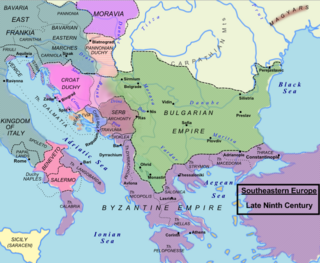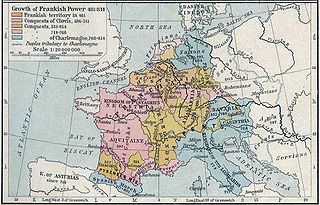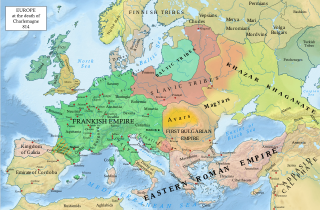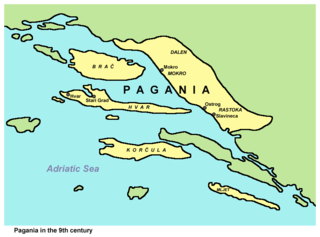Related Research Articles

The Principality of Serbia was one of the early medieval states of the Serbs, located in the western regions of Southeastern Europe. It existed from the 8th century up to c. 969–971 and was ruled by the Vlastimirović dynasty. Its first ruler known by name was Višeslav who started ruling around 780. While by that time, starting from the year 680–681, the Bulgarian state had taken the lands to the east. Vlastimir resisted and defeated the Bulgarian army in a three-year-war (839–842), and the two powers lived in peace for some decades. Vlastimir's three sons succeeded in ruling Serbia together, although not for long; Serbia became a key part in the power struggle between the Byzantines and Bulgarians, predominantly allied with the Byzantines, which also resulted in major dynastic wars for a period of three decades. The principality was annexed in 924 by Simeon I and subjected to Bulgarian rule until 927 when Serbian prince Časlav was established as ruler of the Serbian land, and united several Serbian regions, becoming the most powerful ruler of the Vlastimirović dynasty.

Zachlumia or Zachumlia, also Hum, was a medieval principality located in the modern-day regions of Herzegovina and southern Dalmatia. In some periods it was a fully independent or semi-independent South Slavic principality. It maintained relations with various foreign and neighbouring powers and later was subjected to Kingdom of Hungary, Kingdom of Serbia, Kingdom of Bosnia, Duchy of Saint Sava and at the end to the Ottoman Empire.

The Vlastimirović was the first Serbian royal dynasty, named after Prince Vlastimir, who was recognized by the Byzantine Empire. The dynasty was established with the Unknown Archon, who ruled during the reign of Emperor Heraclius (610–641). The Vlastimirović dynasty ruled in Serbia until the 960s, when some of the Serbian lands were annexed by the Byzantine Empire.

Travunia was a South Slavic medieval principality that was part of Medieval Serbia (850–1371), and later the Medieval Bosnia (1373–1482). The principality became hereditary in a number of noble houses, often kin to the ruling dynasty. The region came under Ottoman rule in 1482. Its seat was in the city of Trebinje.

Ljudevit or Liudewit, often also Ljudevit Posavski, was the Duke of the Slavs in Lower Pannonia from 810 to 823. The capital of his realm was in Sisak. As the ruler of the Pannonian Slavs, he led a resistance to Frankish domination. Having lost the war against Franks, he fled to the south, presumably to Dalmatia, first to an unknown Serb župa, and then to the Croat ruler Ljudemisl, who treacherously killed him.
Višeslav or Vojislav, is the first Serbian ruler known by name, who ruled in c. 780. Serbia was a Slavic principality, subject to the Byzantine Empire, located in the western Balkans, bordering with Bulgaria in the east. Mentioned in the De Administrando Imperio (DAI) from the mid-10th century, Višeslav was a progenitor of the Serbian ruling family, known in historiography as the Vlastimirović dynasty. He was descended from the unnamed "Serbian prince" who led his people to the Dalmatia province and established hereditary rule under Byzantine suzerainty. The names of Višeslav's predecessors were not included in the DAI. The dynasty ruled the Principality of Serbia from the early 8th century until around 960.
The History of the Serbs spans from the Early Middle Ages to present. Serbs, a South Slavic people, traditionally live mainly in Serbia, Montenegro, Bosnia and Herzegovina, Croatia and North Macedonia. A Serbian diaspora dispersed people of Serb descent to Western Europe, North America and Australia.
Vladislav or Ladislas was the Duke of Croatia. In sources he is mentioned as the Duke of Dalmatia and Liburnia, having succeeded his uncle Borna, a Frankish vassal. He is mentioned only in the 9th-century Royal Frankish Annals, regarding year 821. Borna had died between January and October 821, during a war against Frankish rebel Ljudevit, Duke of Pannonian Croatia. Borna's nephew Vladislav succeeded him, by the people's will and emperor's approval. Vladislav ruled from Nin as a loyal vassal of the Frankish Emperor Lothair I. In historiography, his realm has been referred to as Dalmatian Croatia or Littoral Croatia, where he was succeeded by Duke Mislav.

Borna was the Duke of Croatia from c. 810 to 821 and vassal of the Frankish Empire. He resided in Nin and was the ruler of most of the Croats in northern Dalmatia.

Vlastimir was the Serbian prince from c. 830 until c. 851. Little is known of his reign. He held Serbia during the growing threat posed by the neighbouring, hitherto peaceful, First Bulgarian Empire, which had expanded significantly toward Serbia.

Pomorje, also known as the Lands of Pomorje, is a medieval term, used to designate several maritime regions of Upper Dalmatia and its hinterland, that at the end of the 12th century, during the reign of Stefan Nemanja (1166–1196), became part of the Grand Principality of Serbia, and remained part of the medieval Kingdom of Serbia, whose rulers were styled with the title: "crowned king and autocrat of all Serbian and coastal lands".

Vojnomir, Voynomir or Vonomir I was a Slavic military commander in Frankish service, the duke of Slavs in Lower Pannonia, who ruled from c. 790 to c. 800 or from 791 to c. 810 over an area that corresponds to modern-day Slavonia, Croatia.

The siege of Trsat was a battle fought over possession of the town of Trsat in Liburnia, near the Croatian–Frankish border. The battle was fought in the autumn of 799 between the defending forces of Dalmatian Croatia under the leadership of Croatian duke Višeslav, and the invading Frankish army of the Carolingian Empire led by Eric of Friuli. The battle was a Croatian victory, and the Frankish commander Eric was killed during the siege.

Prosigoj was a Serbian ruler believed to have ruled prior to c. 830. Serbia was a Slavic principality subject to the Byzantine Empire, located in the western Balkans, bordering with Bulgaria in the east. Mentioned in the De Administrando Imperio (DAI) from the mid-10th century, he succeeded his father Radoslav and was succeeded by his son Vlastimir.

Radoslav was a Serbian Prince who ruled over the early medieval Principality of Serbia at the beginning of the 9th century. He succeeded his father, prince Višeslav, who ruled at the end of the 8th century. Radoslav was succeeded by his son, prince Prosigoj.

The Guduscani or Goduscani were a tribe whose location and origin on the territory of early medieval Croatia remains a matter of dispute. According to one hypothesis they were located around present-day Gacka (Lika), between upper Kupa river and the Dalmatian coast, or that were inhabitants around the river Guduča near the Bribir region.

Early Slavs settled in the eastern and southern parts of the former Roman province of Pannonia. The term Lower Pannonia was used to designate those areas of the Pannonian plain that lie to the east and south of the river Rába, with the division into Upper and Lower inherited from the Roman terminology.

The Narentines were a South Slavic tribe that occupied an area of southern Dalmatia centered at the river Neretva, active in the 9th and 10th centuries, noted as pirates on the Adriatic. Named Narentani in Venetian sources, Greek sources call them Paganoi, "pagans", as they were for long pagan, in a time when neighbouring tribes were Christianized. The tribe were fierce enemies of the Republic of Venice, having attacked Venetian merchants and clergy passing on the Adriatic, and even raided close to Venice itself, as well as defeated the doge several times. Venetian–Narentine peace treaties did not last long, as the Narentines quickly returned to piracy. They were finally defeated in a Venetian crackdown at the turn of the 10th century and disappeared from sources by the 11th century.

The Theme of Dalmatia was a Byzantine theme on the eastern coast of the Adriatic Sea in Southeastern Europe, headquartered at Jadera.
Administrative divisions of medieval Serbia refer to regional administrative divisions of Medieval Serbia, from the 7th to the 15 the century.
References
- 1 2 3 Živković 2011, pp. 394–395.
- ↑ Scholz 1970, p. 113.